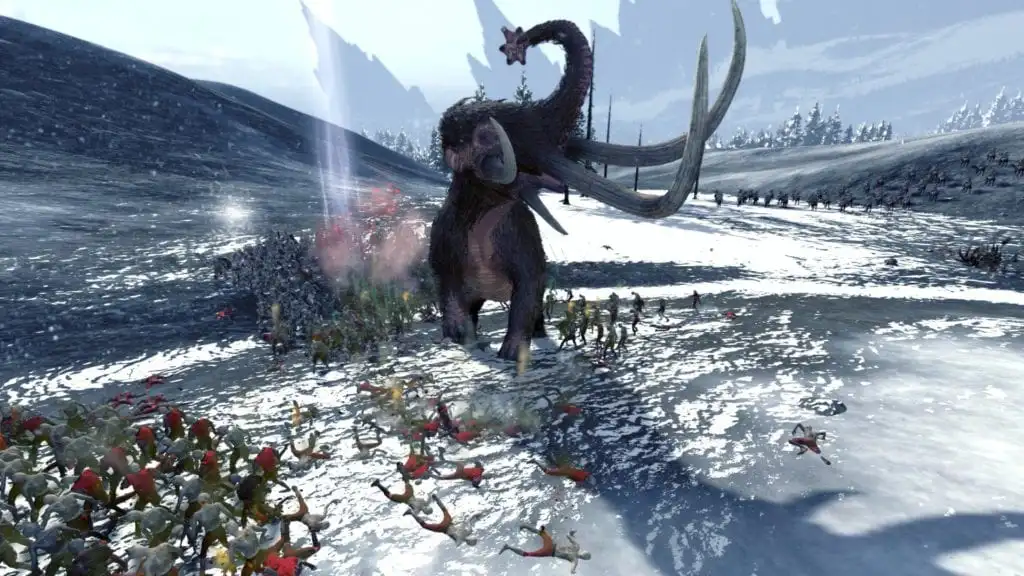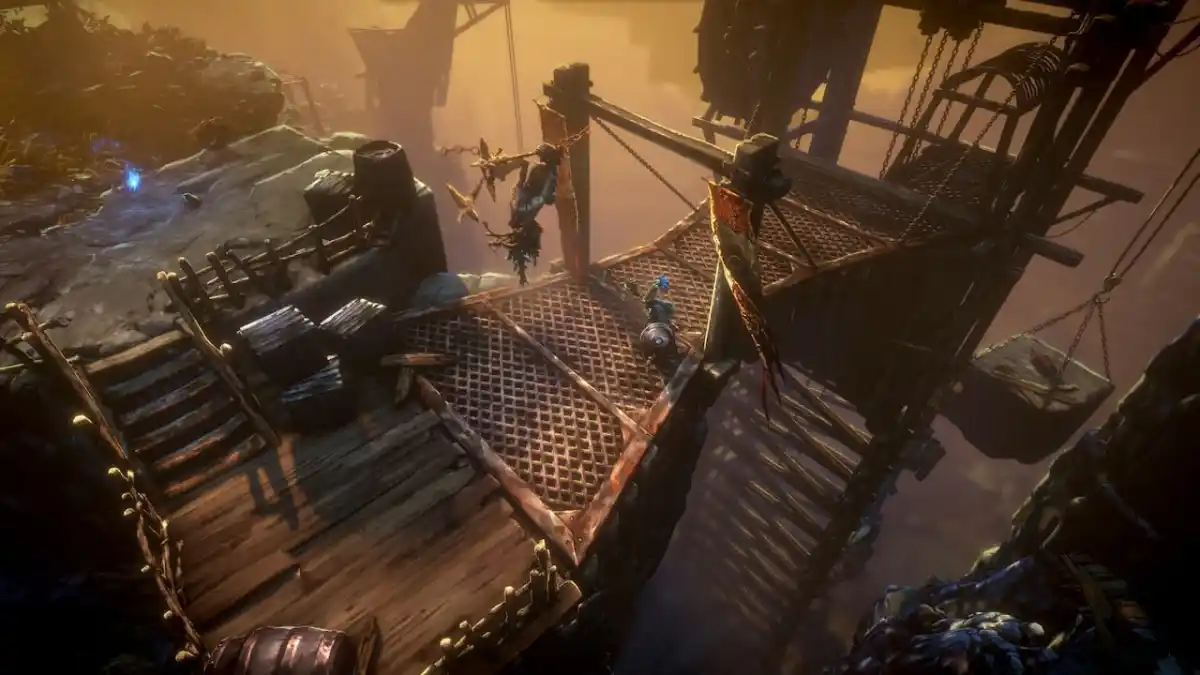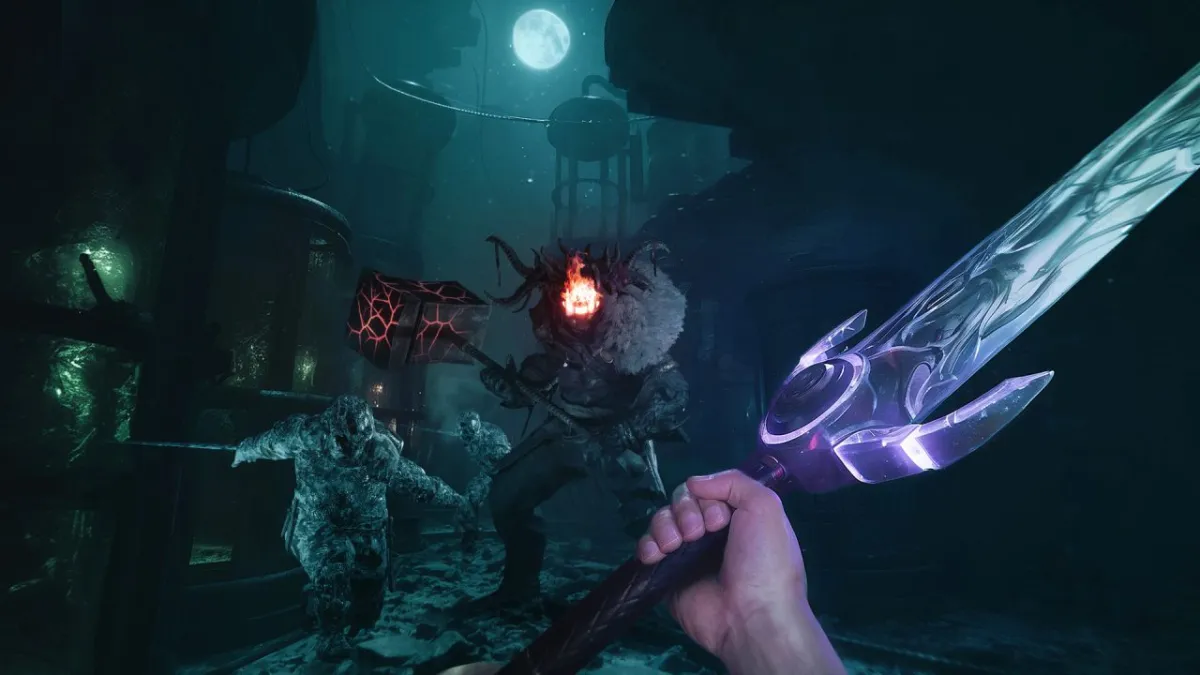You’ve just been handed a coat covered in skulls or a massive hammer, and put in charge of the new Norsca (Wulfrik) or Wintertooth (Throgg) faction in Total War: Warhammer. What now? Now, my friend, you head South for a life of raiding and pillaging at the expense of all who oppose you.
I’ve played through a full Wintertooth campaign for the purposes of review, so I can now share the knowledge of my people. Some of this stuff is Throgg-specific, but the vast majority can be applied to either Legendary Lord.
Norsca Campaign Essentials
The Norsca faction (unless specified, I’ll just be using ‘Norsca’ to mean both them and Wintertooth) do not use the Total War: Warhammer Horde mechanics like Beastmen and Chaos, but operate quite like those factions for strategic purposes. A lot of the time you’ll find yourself roaming far afield, some distance away from a friendly town. You’ll also need to be regularly raiding and (especially) sacking rich settlements to pay for your war efforts.
You should absolutely secure a local province (or two) up North to unlock some specialist troop options in those areas, but those provinces and their taxation will not be able to support you indefinitely. Norsca only have one building dedicated to income generation, and it tops out at 300 gold.
Almost all of the time your army upkeep will exceed your basic income. But it doesn’t matter that you’re losing 2,000 per turn if you have cash on hand to cover it and a couple of towns that are worth 12,000 gold apiece lined up for sacking in the next two or three. The trick is to keep an eye on the expenditure (army upkeep, basically) and judge how sustainable it’ll be against the cash you already have over the coming turns.
As you acquire more gold through raiding, sacking, and external challenges like Hunts and Quests, your per-turn-losses become less relevant. Aim for the wealthier settlements (usually capitals) – you can see how much a city will return when sacked by hovering the mouse over them when you’re within striking distance. By the end of my Total War: Warhammer Wintertooth campaign I had 120,000 banked and enough military power to roll over just about any city I pleased; so it really didn’t matter that my three armies were bleeding out 4,000 each turn.
The trickiest period is towards the end of the early campaign segment (Turns 15-35 or so) when you’re trying to both construct your building chains and expand to two armies. That requires a fair amount of gold, and at the same time you’re increasing your upkeep. Try to aim for any technologies or character skills that say they will reduce army upkeep (or on specific unit types), and take advantage of any random events that come your way (some of them have a temporary reduced upkeep option too).
You’re ultimately trying to knock over settlements and replace them with Chaos totems for the god of your choosing (or several gods if you’re playing the field for a bit). Make sure you sack anywhere that offers a decent gold return before sticking a totem up. You can sack the place first, then (assuming the fight went well) come back the next turn to finish off a weak garrison and put up a totem.
Make sure you convert a few places into actual settlements though. Once you’re quite far South it helps to have a place where you can quickly replenish troops. The smaller coastal settlements don’t have many building slots, but you’ll at least be able to use them to replace Marauders, or maybe some Horsemen or Hounds. Remember too that this Total War: Warhammer faction can replenish casualties (for existing units) anywhere by using the Raiding Camp stance.
Wintertooth Starting Strategy
You start off at war with the Naglfarlings, so take the hint and go for their throat. Recruit two or three basic units (whatever you fancy and can afford), then head off West to grab the two settlements you need to unite your province. One of them has an Obsidian mine that can produce a bit of extra income and trade if you’re inclined to dip into a little Total War: Warhammer diplomacy.
If you make sure your army is a bit weaker than the Naglfarling one, you can bait their stack into attacking you (and then hopefully defeat them with your superior tactics). If not, just go and take the settlement they’re not at and then prepare to take the final one. You might need to build up a decent sized army if they don’t budge from the city and its friendly garrison.
With the province united, now would be a decent time to plan which buildings you want. There won’t be enough slots to be able to produce every type of unit, so it pays to plan ahead a bit and figure out if you need additional constructions like a blacksmith and so on.
Now that you have a base of operations, it’s time to head East and kill the Dwarfs next door. They have a diamond mine which provides some decent sacking revenue.
Around about turn 12 or 15, finances permitting, you want to be starting off a second (smaller, for now) army in a supporting role. That advise applies to most Total War: Warhammer campaigns really.
Once the Dwarfs are dead you have a choice. Either spend more time killing fellow Norsca tribes, or do some diplomacy with them and dive headlong South, into Kislev. The former will allow you to get more provinces (and provide more slots for building variety); and if you go all the way East you can take on Wulfrik nice and early. Doing so will let you secure some coastline properties for straightforward routes into the Empire.
However, Kislev (which is the option I took) have some rich cities to sack, and they have a unique building in Troll Country if you take Erengrad. It allows cheap recruitment of Fimir Warriors and (normal) Trolls, who both start with additional experience. Kislev’s capital can be occupied too, but doesn’t appear to have any special bonuses. Still, it can be a decent outpost for replenishment.
Whichever path you choose, you should have raised a few Chaos totems along the way and end up well positioned to strike The Empire and, later, Bretonnia.
Norsca Starting Strategy
Wulfrik’s starting moves shouldn’t be radically different from those outlined above. You start off at war with Skaeling, so defeat them and unite that first province as soon as possible. After that, you can either beat up some more neighbours (and possibly acquire some territory through confederation, long-term), or head South from your coastal settlements into the Empire.
Like with Wintertooth, try to have a second army up and running around Turn 15 or so.
Reaching Level 3 With Your God, Rewards, and the Chaos Challengers
Each totem placed will earn you 6 points towards your Norsca god of choice. Level 3 unlocks at 100 points, so that’s basically 17 settlements in total. However, you also get a boost from sacrificing the mighty beasts you can defeat in the Norsca hunting quests (I think either 10 or 12 points), so if you beeline for one god it’s possible with destroying fewer settlements than that.
You can spread your favour around with the gods (and get multiple bonuses) until you hit the 100 point mark with one of them. Then the rest get angry at you and you lose previous favours. However, you do get a bonus from your chosen god.
The Serpent gives you a Level 30 Chaos Sorcerer (Fire, Metal, Shadows mix) mounted on a dragon. Serving The Hound gets you a special Hell Cannon artillery piece. If you opt for The Eagle, you can recruit a special Lord of Change as a general for one of your armies. Finally, The Crow reward says it spreads a plague around the world from which your troops are immune. Since I didn’t go down this path I don’t know exactly what the plague does to the rest of the Total War: Warhammer realm, but it’s probably something like global attrition, lowered replenishment rates, more Chaos corruption, or some combination of those.
As soon as you achieve that third level with a god, the other three will send armies after you. First, two will appear from the Northern Chaos Wastes. They’ll head directly for your Legendary Lord (ignoring settlements) so don’t worry about suddenly having to protect distant towns. The armies are strong Chaos compositions, full of Chosen, Chaos Spawn, Chaos Trolls, Warriors, and the like. If the god has a special reward unit (like the Sorcerer), they’ll be present as a foe.
If you want an easy way to beat the first two stacks, remember that they’re heading right for your Lord. Should he happen to be in a fully garrisoned settlement, or have a second stack stood next to him as an ally, then you’ll get a relatively straightforward auto-resolve option.
You can’t use that trick for the third challenger, which appears on the map as a classic Total War: Warhammer quest battle. That means, at least, you can leave it until you feel ready. Again, the army will be a strong Chaos composition, and will receive reinforcements throughout the fight. I battled the Eagle challenger (who was invincible for a short period at the start of the battle), and he had both Norsca and Beastmen friends show up. I’m not sure if that’s the same for the others, but you can practice them beforehand through the Quest Battle option on the main menu if you want a preview of what the fight will be like.
Norsca Army Composition and Unit Types
The Norsca forces in Total War: Warhammer are a core of raging Viking types, monstrous infantry, short-ranged missile support, missile cavalry, and a few expensive, specialty units like Frost-Wyrms and Mammoths. Your infantry, for the most part, is not very well armoured, but can dish out a lot of damage once in combat. The Rage and Berserk mechanics (most of the infantry has one or the other) mean that the longer a unit stays in combat, the more damage it’ll be putting it. Units will get a kind of white smoke effect when Rage or Berserk are popping off.
That, combined with a focus on shorter-ranged missile fire (and lots of melee capable monsters), mean that you should almost always be trying to rapidly close the gap with the enemy. Don’t just smash your infantry into things at random, of course, but make sure you’re not farting around too much on your approach. If you do, you risk taking a lot of damage from factions who lean on war machines and missile troops. Beware of cavalry heavy forces like Bretonnia, because while your army does have counters to shock cavalry, it doesn’t have much cavalry of its own (at least, not in the traditional sense).
If you’re Norsca, Wulrik’s ‘red’ skill line in Total War: Warhammer gives boosts to Marauders. Throgg’s red skills are all about improving Trolls and Fimir.
Marauders: Assuming you have the right building chains in place, you can produce all kinds of Marauder varieties. The basic axe/shield kind are useful as an early screen against enemy missile troops, due to those shields. Don’t have Spearmen or Berserkers on the front line charging at bows or guns, they’ll be very unhappy about it. Keep the guys with shields up top until you’re close.
If/when you can recruit Marauder Champions, those guys are armoured enough to take a few arrows (but, as ever, watch out for armour-piercing damage from guns etc). Early on, the Marauder Spearmen are going to be your most accessible anti-large option (along with Hunters with javelins).
For armour-piercing, you’ll need the Marauders (or, much later, Marauder Champs) with Great Weapons. However, if you’re already building around monstrous infantry like Trolls and Fimir then the armour-piercing duties are probably fairly well covered. You’ll need one or the other once you’re regularly facing armoured dwarfs, higher tier Chaos units and the like.
Missile Options: As mentioned, Hunters with javelins are a solid anti-large choice. If you can pin down a ‘large’ unit (or beast) with some spearmen and pelt it with javelins, you’ll usually come out fine. The later tier Hunters have armour-piercing axes. Note: although both units can somewhat hold up in melee combat, their melee attacks do not appear to have a bonus against large or armour-piercing properties.
Your three cavalry choices are all missile-based too. They all have Vanguard deployment, so they can be prime candidates for hitting stray war machines or just popping up on someone’s flank to be a nuisance. You can also parade up and down in front of the AI’s lines to pull some things out of position. The basic Marauder Horsemen won’t hold well under any missile fire (or a charge from hounds or other knights), but the ones with throwing axes at least have shields. They also do armour-piercing damage which can be handy.
I’m not totally convinced the Horsemasters are worth the extra cost; the basic type have the same major benefits (Vanguard, mobility – in fact the basic Horsemen are slightly faster). Horsemasters’ main selling point is actual armour and slightly better melee/defense stats, but that comes at a pretty heavy price. They are the closest you’ll get to conventional Total War: Warhammer cavalry in this faction though.
Chariots: To be honest I find chariots a little too micro intensive to use very often, so I’m not the best person to offer tactical suggestions for these. I’ll do my best. There are two varieties, a (cheaper) melee one, and an Ice Wolves missile chariot. Both have incredible charge stats (typical for chariots), and I will say the Ice Wolf option is pretty versatile. It has armour-piercing missiles, that very strong charge, and deals Frostbite damage in melee (slowing enemies by about 50%). That makes it a great contextual support unit, but similar cost gets you a unit of Trolls or Skin Wolves.
Release the Hounds: Like with the chariots, you’ve got two options. Basic Norscan Hounds will do the usual tactical jobs given to hounds in Total War: Warhammer; sweeping around flanks, looking for chances to harass isolated war machines, archers, or weaker cavalry. They’re fine at that, like all hounds. Ice Wolves are a bit more special. You can give them similar tasks to the regular hounds, but their Frostbite ability means they’re also very useful as a support against tougher foes. If one of your infantry units is evenly matched or slightly losing a fight, slamming some Ice Wolves into the fray (preferably from the back) will dramatically slow the enemy attacks down.
Monstrous Infantry: A lot to choose from here. Let’s start with Skin Wolves. The Skin Wolf Werekin hero is well worth a mention here, and basically seems to be a slightly worse (but also slightly cheaper) Gore Bull. Since Gore Bulls are top tier unstoppable killing machines, being “slightly worse” isn’t exactly a harsh criticism. The basic unit versions are good too, but particularly the armoured variety. They move a little slower (still faster than most things that aren’t cavalry), but 20% physical resistance, combined with 70 armour and regeneration mean they can take some severe punishment.
The Trolls are, well, Trolls. A good armour-piercing option, especially if buffed by Throgg’s skill tree. Low leadership, of course, so sticking them near your general or a worthy hero is always a good plan. Same goes for the Ice Trolls, who deal more weapon damage than the regular kind and have the same Frostbite effect as the Wolves. By the end of my Wintertooth campaign I had six or seven units of buffed up Trolls traveling around with Throgg and they could hold the line pretty damn well.
Fimir can augment your army in a couple of useful ways. Their Warriors (normal or great weapon varieties) are tough, lower-end-of-top-tier infantry. They’re another armour-piercing option, but, perhaps more important, they’re one of the few units for Norsca who can deal magical attacks (so they can do full damage to ethereal foes). Since magical attacks ignore physical resistance, and Fimir attacks are also armour-piercing and sundering (reducing armour), they should be dishing out a lot of damage with each swing.
Other Monsters and Mammoths: The Feral Manticore and Giant are the same as the versions which appear on other Total War: Warhammer rosters (the Norsca Giant has its own red-nosed style though). They’re fine, but arguably less exciting than Norsca’s unique monsters. The Frost-Wyrm has very similar stats to the Wood Elf Forest Dragon, but it’s not a siege attacker (sadly) and it takes increased damage from fire. However, in return, it also gets the Frostbite effect on its attacks. Very useful as a mobile distributor of negative speed status effects.
Now, everybody’s favourite woolly friends, the Mammoths. Even the lowest variant (the Feral Mammoth) has a huge amount of hit points (8,850; more than a giant). The War Mammoth has over 10k, which is kind of insane. All of the Mammoths are anti-infantry and cause terror. All of them are siege attackers (because who’s going to win between a castle door and a mammoth?) Send these guys into the infantry fray and let them soak it all up while dealing carnage. If they attract all the attention (particularly anti-large attention, or lots of armour-piercing missiles) they can of course be in big trouble; but in that situation it means the enemy are focusing basically everything on one creature. That’s a prime opportunity for the rest of your army to sweep in where it pleases.
The War Shrine Mammoth variation can even bestow fire damage abilities and more leadership on nearby infantry. Basically, there’s every reason to point Mammoths at almost every cluster of troops you see, as long as they have some support.
Magic Options: Your Shaman-Sorcerers give Norsca the choice of Fire, Metal, and Death magic, and the Fimir Balefiends have both Fire and Shadows covered. That’s a pretty decent spread of Total War: Warhammer spell schools to select from, and the Fimir casters can also hold up pretty well in a fight (useful for a normally vulnerable character). I’m partial to the Balefiends for that reason, and because the Lore of Shadows has some helpful hex-type spells in it to aid your warriors in melee.
Now, with this knowledge, head South and tear the lands asunder in your pursuit of gold and glory.
Read the PC Invasion Total War: Warhammer Norsca DLC Review.
















